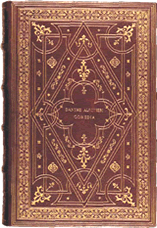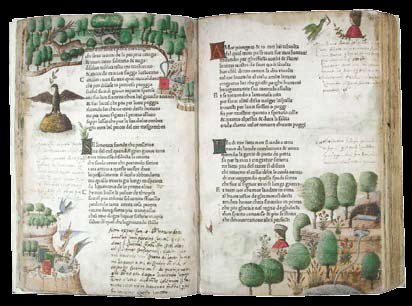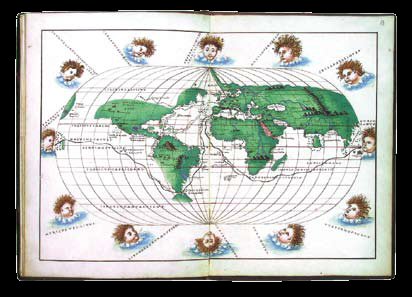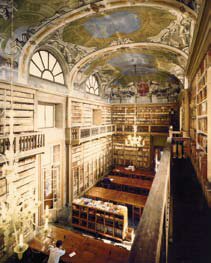|
www.fellowshiphistory.org
Rotary International Fellowship - “Old and Rare Antique Books and Prints”

The Fellowship is open to:
Rotary – Rotaract – Interact – Inner Wheel

Its aims are:
• Promoting friendship and the exchange of information on a global scale among those
Rotarians who share a common interest for antique books and prints;
• Transmitting the knowledge and love for old books to other Rotarians, especially
the younger ones;
• Taking advantage of the latest means of communication, which allow an easy access
to a heritage which, in our District, happens to be among the richest in the world.
During its initial stage, the Fellowship will operate thanks to
the generous support of Biblioteca Queriniana di Brescia (one of
the oldest and most famous libraries in the country). We shall
benefit of its computer facilities and of the assistance of its
Director Aldo Pirola, who is to be appointed Secretary of the
new Fellowship.
As requested by International Regulations, the initiative has
received the approval of three Governors of three different
countries, and was approved by the Central Council of Rotary
International in November2006.
It has therefore been enclosed in the list of the Rotary
Fellowships and is, to all intents and purposes, already active
on the website: rotaryoldbooks.org
Why this kind of fellowship:
• Because among Rotarians all over the world there are numerous
keen connoisseurs of antique books and prints;
• Because our District and Italy in general are abundantly
endowed with this kind of cultural heritage, which, being
unique, deserves protecting;
• Because the present internet facilities permit such access and
consultation as were unthinkable in the past.
But above all because -
• Culture is the one element that offers multiple opportunities
for a harmonious dialogue with the different realities of our
world and our society.
• Because the cultural advancement of mankind is as relevant as
its economic and social progress.

We trust that our project will succeed in promoting both
knowledge and love for old books, while creating a pool of
information accessible to all Rotarian bibliophiles, among which
we have the pleasure of mentioning the Present President Bill
Boyd, who quite recently declared to belong to a family of book
lovers. We also hope that the use of internet will help
overcoming the well-known lending reluctance that affects most
bibliophiles, a diffidence which was well expressed by a
medieval bibliophile:
Librum meum non prestabo, si prestabo non habebo, si habebo
non tam cito, si tam cito non tam bonum, si tam bonum perdo
amicum: Ergo nolo praestare librum.
Culture in the Rotary Clubs to the advancement
of society
“It behoves to culture to promote new ideas and
needs less tied to material objects, to form a class of better
educated and civically conscious citizens, to create the means
by which foreign cultures might meet, to promote the knowledge
of foreign languages for better communication, enhancing not so
much what is local but what is common to all”.
These meaningful words are, in my opinion, a compendium of the
role culture should play, becoming a source where a person, who
accepts life both as a challenge and a responsibility, might
find his/her proper spiritual nourishment. According to the most
advanced interpretation in anthropological research, by
“culture” one generally means the entirety of experience,
learning, system of values, choice of ways of life and modes of
behaviour, through which an individual may refine and express
the peculiar spiritual talents and physical endowment that will
permit him/her to attempt at gaining power over nature through
the discovering of its laws, and at modifying some of its
aspects by means of sustained effort, while striving to make
life within society more acceptable, both at family and
community levels promoting personal habits and institutions.
From a historical point of view, on the other hand, culture
expresses, communicates and preserves works that transmit the
great experiences and spiritual aspirations of mankind, thus
putting itself at the service of its progress.
Thus perceived, culture is every nation’s special heritage,
reflecting their spirit and initiative, creative powers,
technical and practical abilities, thus embodying the very
reasons that made that nation, through the endless running of
the centuries, worthy of respect and consideration. It is
therefore hard, not to say impossible, to imagine that culture,
the very product of intelligence and will power, which expresses
the peculiar identity of each human being, might be turned into
an element of restriction, of subordination, and an obstacle to
the growth and development of mankind. Culture can and must be
the foundation of any true moral and civic advancement of a
nation.
Unfortunately, in the course of the twentieth century,culture
did not progress as one might have wished or indeed expected; on
the contrary, it suffered from long periods of profound
disorientation condemned, as it was, to secondary roles of
subordination. The causes of what may correctly be defined a
cultural crisis are to be found in the historical circumstances
that characterised the century.
The whole world as well as our own country are overcome by the
winds of insecurity, fear, mistrust, and anxiety about the
future. But if we show the will, the energy, and the courage to
restore life and voice to culture, there may be good reasons for
hope.
In particular all of us Rotarians, in an effort to dispel this
deep feeling of disorientation, ought to take upon ourselves the
heaviest burden of responsibilities towards the community, the
environment, and every single human being. Fulfilling this duty
represents an indispensable basis to prove our awareness of the
significance of the facts, when they relate to the fundamental
meaning of life, of the environment, of solidarity, in short, of
the individual as a person called by destiny to transcendence.
Not only do the study of humanities and culture restore our
dignity as human beings, but they provide us with the correct
choices whether political, economic or social. Moreover, culture
gives a meaning to all daily events, both private and public,
whereby a horizon of hope might open upon present and future
history.
Welcome to culture, then, which has been scorned, forgotten, and
often manipulated to achieve base ends.
It will offer us food for discussion, thought, and investigation
upon issues that concern all of us, and would otherwise be in
the hands of the few, let alone remain unresolved. What is
needed are reference points that may prove firm and open to
testing.
What is needed is going back to truth, to a culture free from
conditioning, from ideologies, not enslaved by regimes or
parties, as in the worst of tyrannies. Culture will prove to be
our best instrument in rising from the dev– astation suffered by
the moral values of our country and to restore us to the rank of
nation. “The common glories of our past, the common will for the
present, having accomplished great feats together, the desire to
accomplish more, these are the fundamental conditions for the
making of a nation. A heritage of glories and remorse for what
concerns the past, a common project for the future: the
existence of a nation may be considered a daily plebiscite.”
I had a telephone conversation with dear Prof. Tristano Bolelli,
founder and long President of the Galileo Galilei Award. On that
occasion he reminded me that words are the essential vehicle of
culture, the voice through which some of the great Muses find
expression. Obviously as we all know Prof. Bolelli was a great,
illustrious glottologist. Nor am I less convinced of the
fundamental importance of the “word”.
Accordingly, since its earliest days, Rotary was especially
concerned with the transmission of science, culture, and
information. And we Rotarians, Paul Harris’s distant heirs,
cannot but share his concern, and we pledge to renew his
commitment, convinced as we are that learning and knowledge mean
understanding, and understanding will generate mutual respect
and friendship, which are among the noblest Rotarian ideals.
With a view of exalting the functions of intelligence, science,
and culture, Rotary Italy created the Galileo Galilei Award,
which grows yearly in importance and recognition, so as to be
considered the Italian Nobel Prize.
Our District is proud to announce that a project has been
recently established as a Rorary Fellowship (Old and Rare Books
and Prints). It is a socially and culturally worthy initiative,
aimed at promoting friendly global exchange of information among
those Rotarians who share the love for antique books and prints.
And since I am aware that a new mode of thinking is on the way
among the best educated and attentive minds, a trend that
somewhat looks back to a more balanced relation between the
material and the spiritual, I feel entitled to express such
attitude. If this idea is right, then it is up to us Rotarians
to translate it into realistic terms by planning and promoting a
number of specific cultural and educational projects, covering
all possible levels especially destined to the younger
generation since they represent our future.

Allow me to start a conversation on antique books with this
self-evident truth:” None of us would be what we are had our
forefathers not possessed the instrument that enabled them to
hand down to us the knowledge of what they were and did!”
Generation after generation, even the most distant in time, have
left their imprints on the planet. Prehistoric man was a person
like any of us, complete with his own complex inner self; and
yet he could but carry such “human” heritage to his grave,
because, deprived as he was of a writing system, he was unable
to give it permanence. Indeed, it is writing that marks the
discrimination between documented fact and Prehistory The road
to the development of writing was long and even now is partly
undiscovered: probably the process involved the gradual
representation of reality, together with all its relative
concepts, in a more and more abstract manner, by means of
pictograms and ideograms, following models employed in Egypt and
in the modern Far East.
In time, such signs must have acquired a phonetic value to replace the conceptual one,
becoming, within the Mediterranean area, proper alphabet letters, through the composition of
which, it was discovered one could create an infinite number of words to cover the endless
demands of factual life. In fact, the “invention” of our writing system is attributed to the
Phoenicians, a nation given to commerce. Nevertheless, beside a durable mode of transmission of
thought (the alphabet), it was imperative to find a solid material to imprint, i.e.
writing material. Nature offered stone, and later metals. During an archaic stage, the inner
part of bark was used, which in Latin was called “liber”. But it was undoubtedly the Egyptian
papyrus that emerged as the writing material more apt to have a durable employment,
not least due to the Rare Antique Books and Prints ductility and resistance provided by strips
made by intertwining the fibres from the stems of this plant, which grew plentiful on the banks
of the Nile. Such strips could easily be rolled on and off a wooden pivot, forming a scroll
called “volumen” from the Latin verb “volvere”, meaning rolling.
The intensive exploitation of the papyrus plantations and the difficulties in procuring
it promoted the usage of a different type of writing material, which had been
invented and used for centuries in the town of Pergamum, i.e. parchment or vellum (pergamena).
It consisted of the skin of a young animal (lamb, goat or calf), duly prepared, smoothed out
and cut in sheets, which were then sewn together to produce a series of pages, thus
representing the prototype of the modern book format.
Out of each single animal one could obtain about four parchment sheets; consequently, in order
to copy a Bible, it would have been necessary to sacrifice a whole herd. This also explains why
books were, during the whole length of the Middle Ages, extremely precious and rare objects,
mainly produced in monasteries, where flocks of sheep and herds of cattle were abundant. The
rarity and preciousness of books demanded their being ornamented by polychrome decorations of
considerable artistic level; hence, the art of miniature illumination, cultivated for centuries
within the medieval scriptoria. In fact, following the fall of the Roman Empire, illumination
was for centuries the only form of pictorial art cultivated in the Western world.
Working conditions in a monastic scriptorium must have been dire. Freezing in winter, scorching
in summer, tall and very hard desks, lack of any form of enlargement tools, and the necessity of
self producing the ingredients needed for the job – colours made out of
herbs and flowers, ink out of soot, or even gold and silver, brushes from the hair of
animal hides and bird feathers to write with – all of which meant rigidly
disciplined amanuenses, whose endeavours produced such great masterpieces.
For centuries, the making of books went on by these methods until, around
the middle of the 15th century, something occurred that would change the destiny of mankind: the
introduction of the printing press by Johann Gutenberg. In the region surrounding Mainz, presses
had been used for centuries, both to press grapes and house-linen. What Gutenberg
envisaged was the possibility of an innovative application of the press to his own true great
invention: the movable types. By pouring an alloy of molten metals into special moulds, he was able to obtain
the different letters of the alphabet, which would then be assembled and disassembled to form words.
Later, by putting the stencils obtained by such process under the press, it became possible to
print the text upon a sheet of paper or vellum. By then, paper made, according to
the Chinese technique, out of rags had become of common usage in Europe. The impact of the new
technique represented a true revolution, since it made it possible to produce books in large
numbers – the new concept of edition – at much lower costs compared with the medieval
manuscript. The greater circulation of books was the answer to the increased demand for education
of the period, and was the vehicle of Humanism in Europe, together with Renaissance, the
protestant Reformation and, along those lines of Enlightenment and of all the vast and articulated
ideas which characterize the world we live in. The following centuries saw a growing and
better development of the printing methods until mechanical printing machinery was replaced by
digital computerized technology. Thus we come to our epoch, beyond the fateful year 1830, which is indicated by the
world competent organizations (IFLA = International Federation of Librarian Association) as the
discriminating date between antique and modern books.
The Rotarian Fellowship recently founded represents an instrument for knowledge and research
into the reality of antique books. Thanks to it, it will be possible to circulate news and
information regarding editions, publishers, bindings, illumination, particularly
interesting copies from historical, scientific, and economic fields, opening new perspectives
of discovery into a territory that has been so far lacking in adequate research and in-depth
investigation.
Aldo Pirola
BACK TO FELLOWSHIP LIST
To include your fellowship's history send a message
at
www.historycomment.org
acknowledgements to the Fellowship members and Webmaster
posted by RGHF Webmaster, Greg Barlow. March 2009 |

